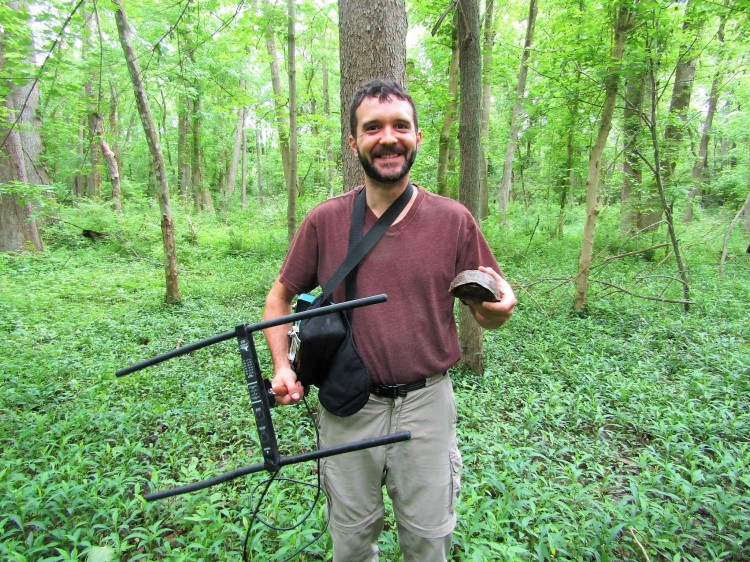
Why is Adam Haas so happy? He’s just found his first transmitter-equipped Box turtle, and it wasn’t easy! The IU Southeast student works at a wildlife rehab center in Indiana, and is one of two “turtle trackers” you may see in the forest this summer. Adam and fellow tracker Nolan Sawtelle are assisting their professor, Dr Omar Attum, in a radio telemetry study of female Box turtles – the first ever at Beargrass Creek State Nature Preserve.
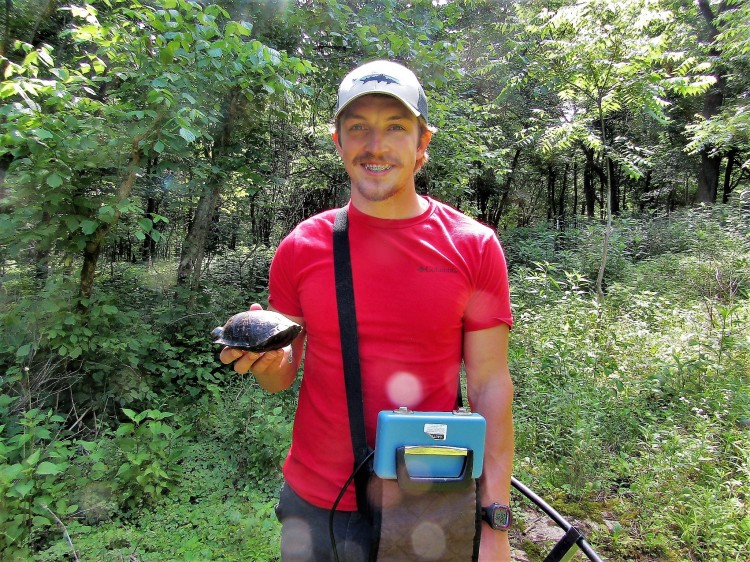
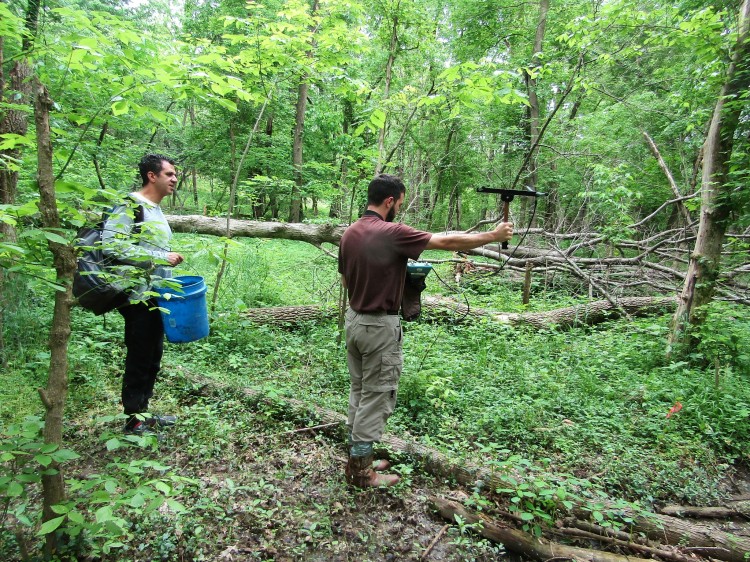
The study’s aim is to map the movements of female turtles by re-finding them at weekly intervals and noting their location. The morning this pic was taken I walked around with Adam and Dr. Attum for an hour, going back and forth, back and forth, trying to get a clear signal with the receiver antenna. It was an exercise in patience, as the elusive signal seemed to wander about, though the turtle was surely almost underfoot. The mucky bottomland already had dense spring undergrowth, and we could have literally stepped on the poor boxie before seeing her! I was pretty sure she wouldn’t be found, but Adam persisted; just as I was leaving he called out the good news.
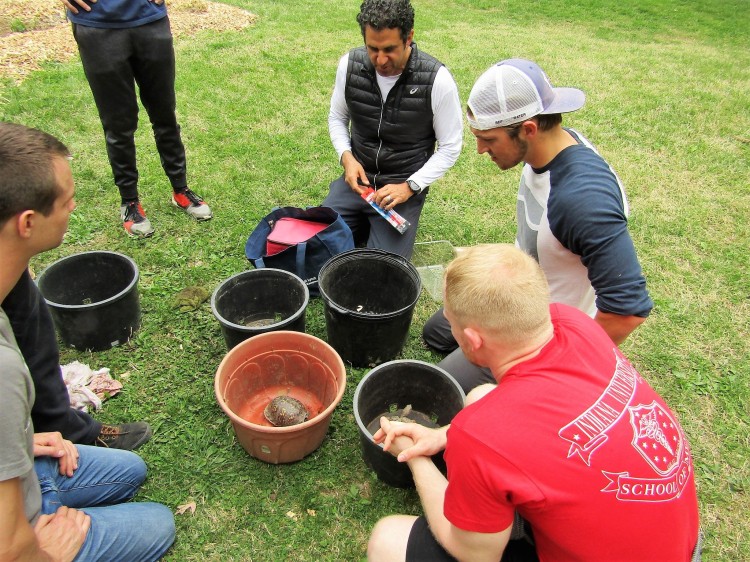
A couple weeks earlier, Dr. Attum’s biology class had spent a morning searching for female turtles in the forest, and this was the result. Box turtles were out and active that morning – within two hours they found five boxies to be fitted with transmitters.
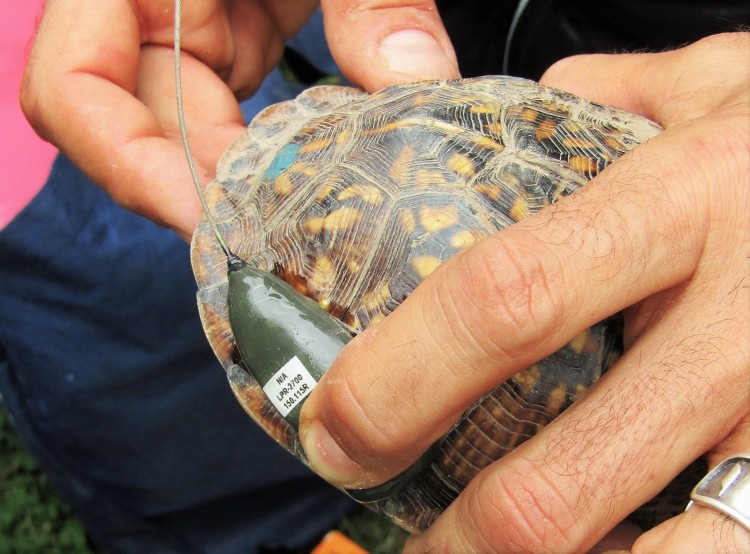
The small transmitters are glued on with epoxy near the rear of the carapace, and will be worn for one year. They’re placed carefully to allow the boxie to go about her business without hindrance. By next spring, the brittle epoxy will pry off easily from the carapace, and the turtle will go incognito again. Meanwhile the turtle trackers will do a weekly check-in to get an overall picture of each turtle’s movements.
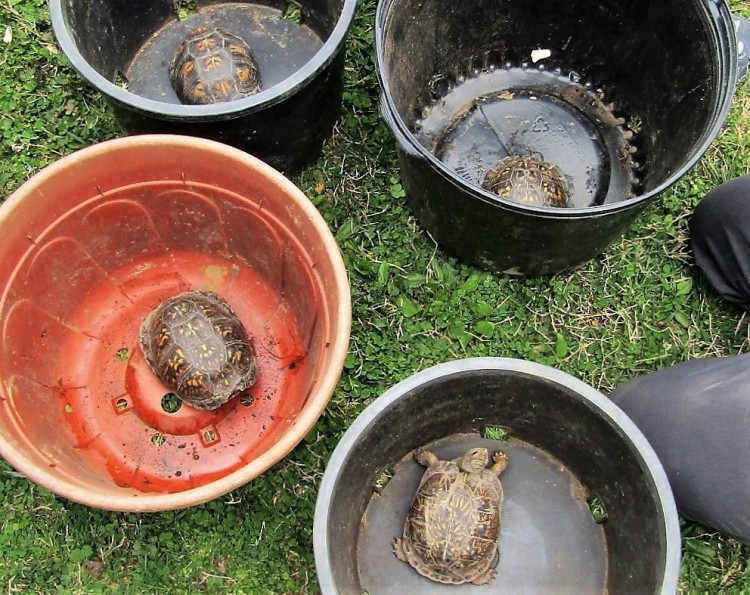
You may wonder what the point is of tracking an animal that spends most of its slow paced life in a home range the size of a football field. But at certain times a Box turtle’s life can be quite hazardous – particularly for females (the subjects of this study). When female boxies need to dig a nest, they often venture out of the shady forest environment to the warmer edge. For the eggs to incubate properly, temperatures in the nest have to be between 72 and 94 degrees – pretty warm.
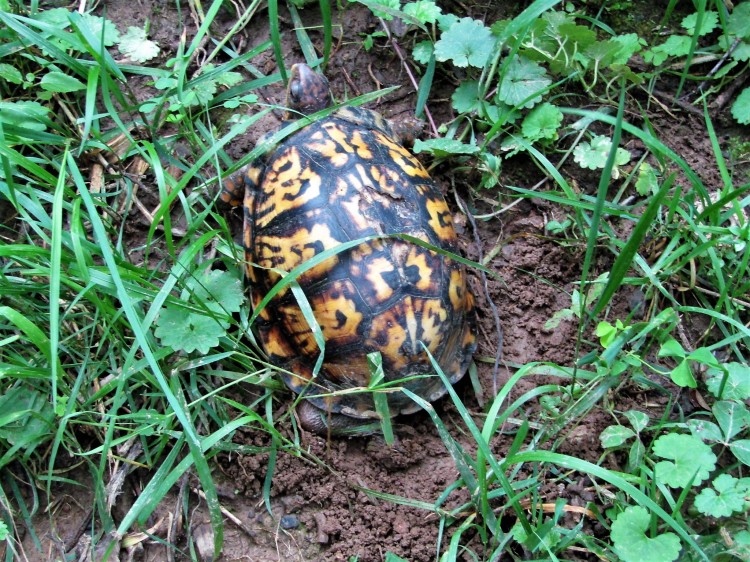
Unfortunately, in today’s world, just traveling to their nest site may put female turtles at risk of being run over by a mower or car. Nesting females often use the same area year after year – so if it happens to be on the other side of a road, survival odds are not good. In fact, in many areas there is an unbalanced gender ratio, with more males than females in the adult population. This seems to be the case at Beargrass Creek SNP, where the 6 years of data I have collected on over a hundred turtles, shows an almost 2:1 ratio of males to females. The question is – are female turtles fewer because of the dangers they face?
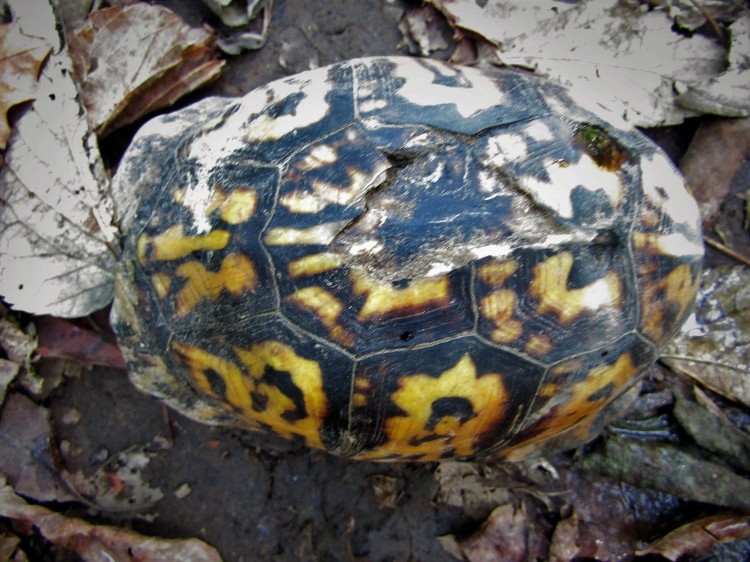
These boxies were encountered near the Louisville Nature Center, where there is a lot of mowed “edge”. Both show healed damage on the carapace that was likely caused by a mower. At least they survived – I have seen a good number that were crushed. (The message here – please check before you mow, and if possible, don’t do it in the evening if there are boxies on your property. Females start digging their nests at about 6:00 pm.)
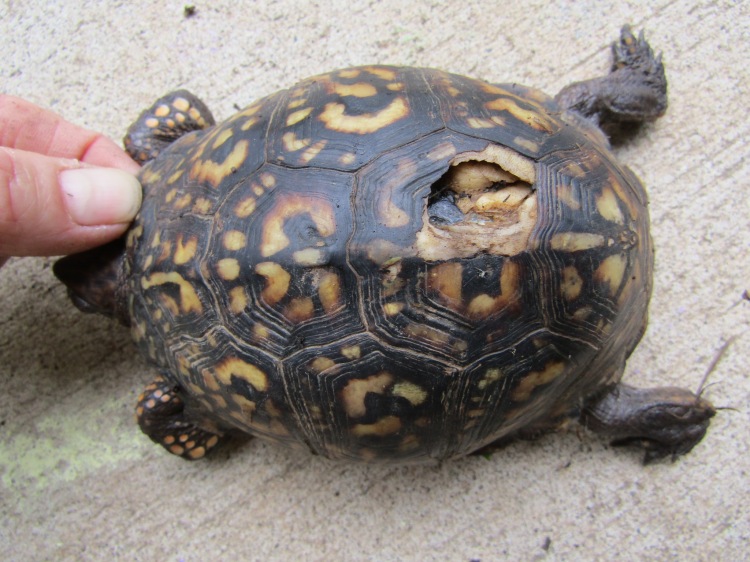
Another possible reason for fewer females is the temperature in the nest. Box turtles, like many reptiles, have no sex chromosomes. Gender of the embryos results from a mechanism called “Temperature Dependent Sex Determination”, with more males produced at cooler nest temperatures, and more females at warmer ones.
But forests like this have been overwhelmed for decades by large, heavily shading bush honeysuckle shrubs. This shading may have caused nest sites, even those near the edge, to be cooler than the forest environment that Eastern box turtles are adapted to, possibly skewing gender ratios. Habitat is improving fast however, as we continue to push back on invasive shrubs. The forest-wide decline of ash trees is also creating more light filled gaps.
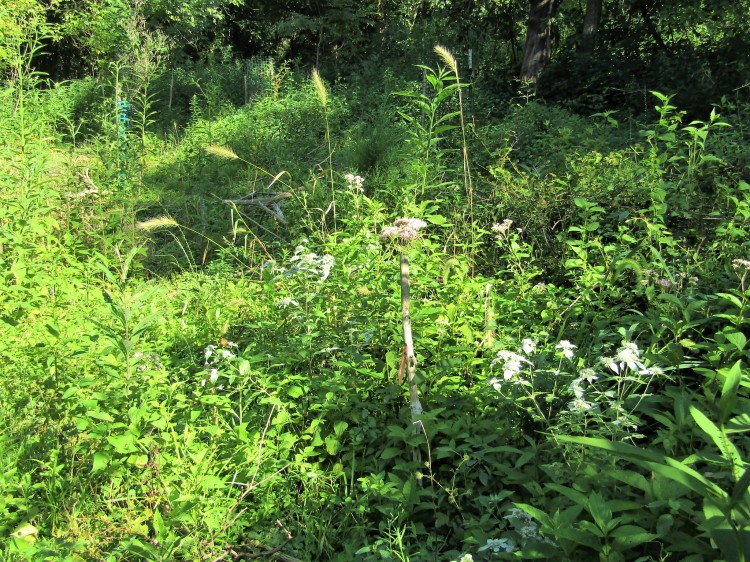
Of course Dr. Attum’s study can’t answer all these questions, but for this forest it’s a great start. Adding to the fund of knowledge through many different studies helps flesh out our understanding, particularly of hard-to-find animals like Box turtles.
Already, an interesting behavior that’s a little outside the norm has been observed. A female boxie wearing a transmitter who lives close to the LNC building and sensory garden, was for two weeks in a row tracked to the small frog pond in the garden. But a closer search showed she was not on the edge of the pond or even near the water’s surface. When the tracking team told me, we searched the pond area once more, then I bravely stuck my arm in, expecting to produce a drowned turtle. I found her right away – and she was fine, apparently staying submerged for surprisingly long periods of time.
Just yesterday, I encountered by chance one of the female turtles that received a transmitter in spring. She was only about fifty feet from where she’d first been spotted, and her tracking record likely shows very little movement. Judging by the degree of wear on her carapace, she’s an older turtle. Since she lives in an area that includes a nice sunny meadow, I hope at least some of her nests survive predation.
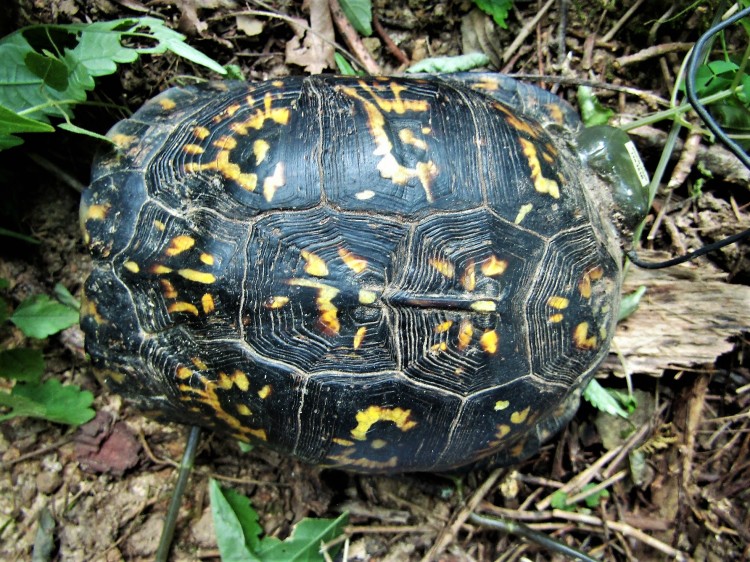
Speaking of nesting, forest steward Dick Rauh was lucky enough to come upon this pair busy with the activity that precedes it – let’s hope for many more baby Box turtles!
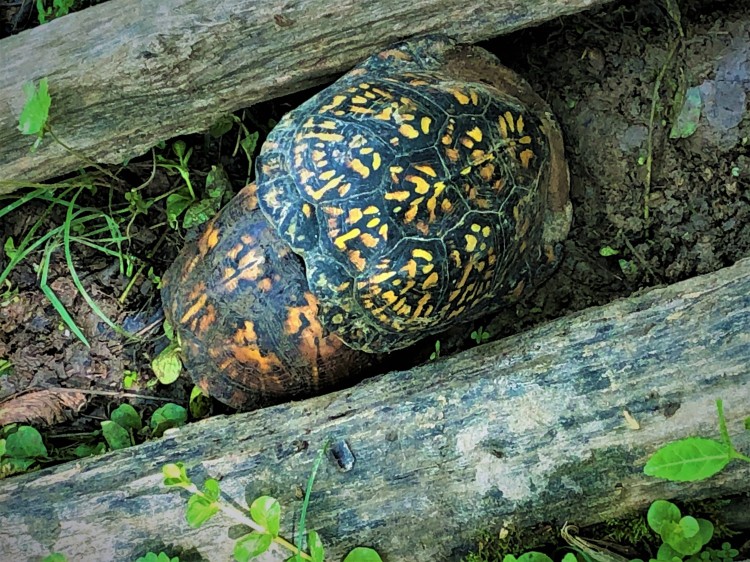
If you’d like to learn more about the study, watch for upcoming LNC field trips to join the team for a morning of turtle-tracking! (I’ll post it here too).
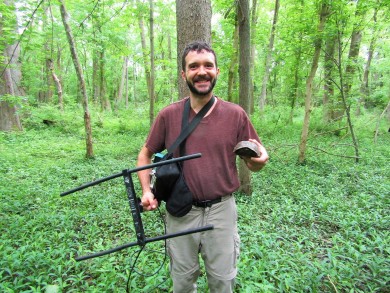
Jeff Mattingly
As a Box Turtle enthusiast and photographer I have been fascinated with these interesting reptiles for decades. This sounds like an outstanding research project to say the least! Keep up the great work and let me know if you ever need assistance with this project.
LikeLiked by 1 person
oneforestfragment
Thanks Jeff – I enjoy your Box turtle pics and posts as well!
LikeLike
Jeff Mattingly
I grew up in the western part of Kentucky and became enamored with Box Turtles as a youngster. Even now in my early 50’s I’m *still* just as fascinated with these animals if not more so. I really began focusing on photographing Box Turtles a few years ago and visit a couple of seemingly stable populations in Nelson County outside of the Bardstown area. They really are survivors in every sense of the word.
LikeLiked by 1 person
oneforestfragment
I am glad to know there are some places they are still doing well. One of the problems with assessing the health of populations, is that baby turtles are just so hard to find! But if younger age classes are being observed over time, that is a good sign. Populations that are not thriving have mostly older individuals, which is a reflection of what the situation was as much as fifty years ago. Nowadays very few nests are not predated in areas with a large population of raccoons, possums, etc.
LikeLike
shoreacres
What a great — and interesting — project. Turtle tracking sounds like a great deal of fun, as well as providing good information. I was especially interested to learn about the females’ tendency to travel to nesting sites. There are certain roads around here that are known for unfortunate car/turtle encounters in the spring; that may help to explain why so many seem to be on the move at that time.
LikeLiked by 1 person
oneforestfragment
Rainy weather, males looking for females, and females going to nest are all reasons for boxies to move about more. I’ve been informally collecting data on the Box turtles of this forest for six years, and it’s one of the best perks of being a forest steward. Spending a lot of time away from trails, either cutting invasive plants, or planting native ones, allows for many turtle encounters.
LikeLiked by 1 person